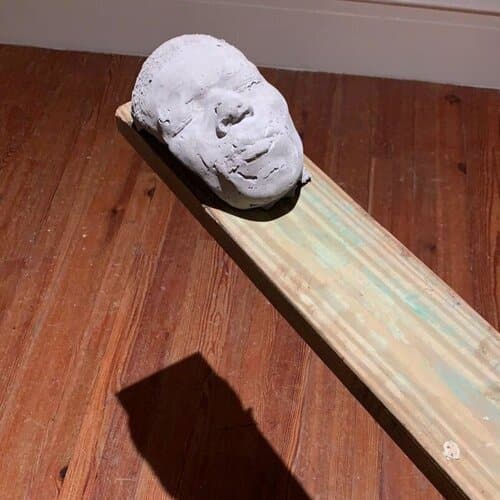EXHIBITION
Balance: Edrin Symonette
Thursday, November 5, 2020
Sunday, May 2, 2021

Symonette‘s Balance: A situation in which different elements are equal or in the correct proportions, currently resides in the NAGB’s Art Park. Guests are welcome to visit Balance which will be featured at the NAGB Art Park from November 5, 2020 until March 8, 2021.
Post-Dorian Bahamas is struggling to find balance after homes, property, family archives and lives were uprooted, lost and displaced. Originally conceived as part of the “Refuge” Open Call for works, Eleutheran artist Edrin Symonette gives us an intimate setting to consider the role of citizenship in preserving dignity and humanity after disaster. Given recent deportations of Haitian and Haitian-Bahamian survivors from their longstanding communities in Abaco in particular and the displacement of many of those survivors to Eleuthera, Symonette wants us to consider the importance (or lack thereof) of nationality in a time of climate crisis.


Artist Biography
Edrin Symonette was born in 1986 and grew up on the rural island of Eleuthera in the Bahamas. Edrin’s work focuses on communicating ideas through the process of construction. Solving each unique problem through the exploration of material and concept is of utmost importance. It is through this juxtaposition of natural and unnatural, traditional and non-traditional that he believes his interpretation of identity and beauty in the world is satisfied. Recently, Symonette’s work has moved away from traditional content and implementation, and he is now focused on communicating his ideas through a process. Solving each unique problem through the exploration of material and concept is of utmost importance. It is through a juxtaposition of natural and unnatural, traditional and nontraditional, that he believes his interpretation of beauty in the world is satisfied.
Installation
Curator’s Essay
by NAGB Associate Curator, Natalie Willis
Post-Dorian Bahamas is struggling to find balance after homes, property, family archives and lives were uprooted, lost and displaced. Originally conceived as part of the “Refuge” Open Call for works, Eleutheran artist Edrin Symonette gives us an intimate setting to consider the role of citizenship in preserving dignity and humanity after disaster. Given recent deportations of Haitian and Haitian-Bahamian survivors from their longstanding communities in Abaco in particular and the displacement of many of those survivors to Eleuthera, Symonette wants us to consider the importance (or lack thereof) of nationality in a time of climate crisis.
As Symonette’s sculptural practice consists of producing life-casts from the bodies of his subjects, his process is a tactile, close, and deeply intimate one. Getting into the crevices of another’s skin calls can create a lack of barriers and personal boundaries in the exchange. With this in mind, vulnerability becomes a requirement for those who agree to enter this process with him. For “Balance: A situation in which different elements are equal or in the correct proportions” (2020), Symonette asked two 19-year-old Haitian-Bahamian twins from Blackwood, North Eleuthera, for permission to make a copy of their likeness in concrete. This process of casting was paired with an interview in which the twins were asked questions that many Haitian-Bahamians face in their everyday lives. Most notably for the twins, at the age of 18 they, like many young people in their situation, encountered a common scenario in this country: they were faced with the decision of having to renounce their Haitian citizenship (which they often have not formally received in the first place) in order to obtain Bahamian citizenship and formal legal rights to live in The Bahamas. The interview reveals that the twins are adamant about their right to be both Bahamian and Haitian and are rightfully agitated at the confrontational nature of being incessantly asked about their origins though they were born and raised in Eleuthera.
What we see is a balancing act – just as the twins are individuals and also identical to each other, so too are many Bahamians juggling and negotiating a status of dual citizenship. The Caribbean is a complex, syncretised space, blending together West African, European, Indigenous, Latinx, and Indo-Asian bloodlines. The idea of nationality and citizenship are made all the more complex in our space of nomads and migrated peoples, and the politics of mobility and freedom of movement are often most difficult for those who are the most vulnerable, as Symonette gently highlights in this work of displaced bodies.